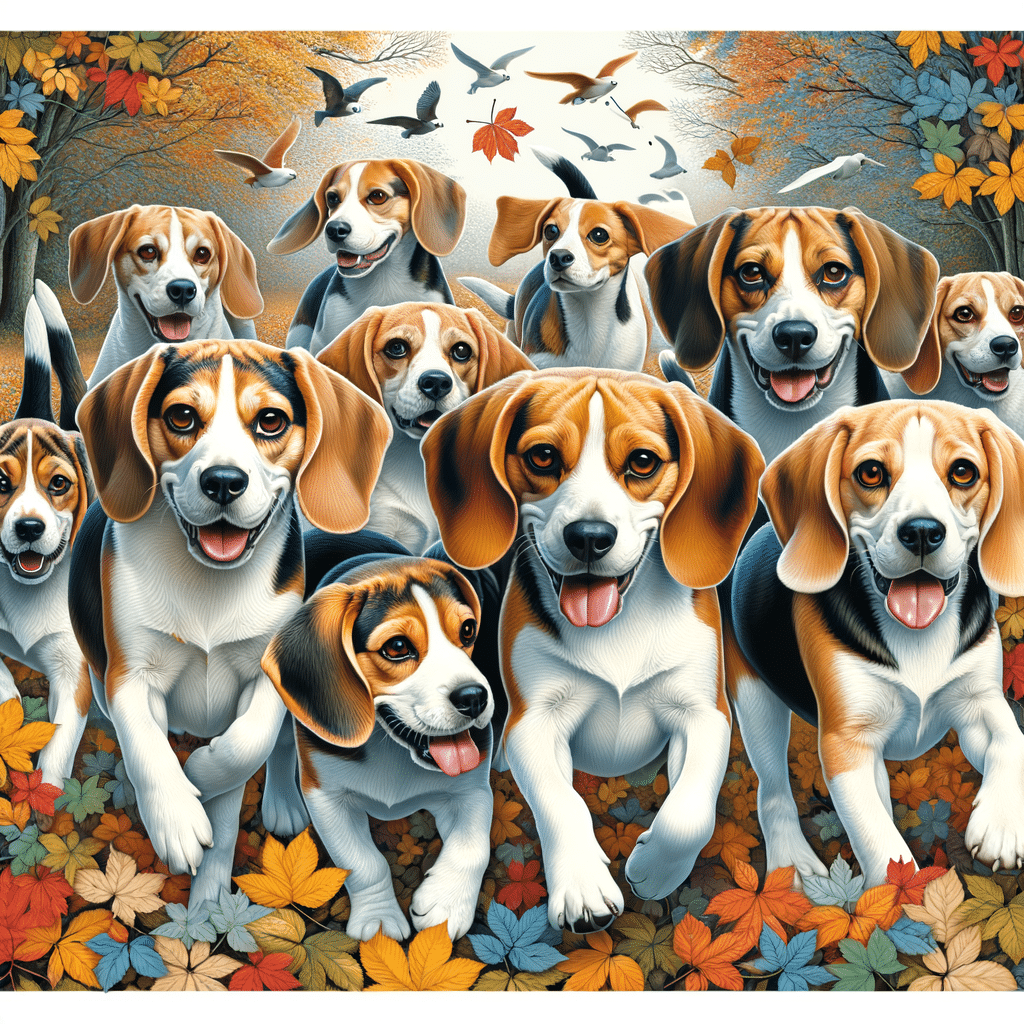Beagles are a popular breed known for their friendly disposition and manageable size, making them a favored choice for many dog owners. The height of a beagle varies with two recognized size categories–those standing under 13 inches at the withers‚ or shoulders and those within the 13 to 15-inch range. As a breed, beagles fully mature in height around 18 months. Their weight can change based on factors such as diet and exercise.
In This Article
Understanding the growth expectations of a beagle is essential for any potential or current owner. The typical height for a full-grown male beagle ranges from 13 to 16 inches, while an adult female may stand between 12 and 15 inches. These dimensions indicate a sturdy and solidly built breed. Monitoring the growth curve of a beagle puppy is crucial to ensure it is developing healthily and to prevent issues related to over- or underfeeding.
Highlights
- Beagles come in two sizes: under 13 inches at the withers and 13 to 15 inches at maturity.
- Full-grown male beagles stand 13 to 16 inches tall, and females range from 12 to 15 inches.
- Growth in height concludes around 18 months, but weight can still vary afterward.
Understanding the Beagle Breed
The beagle breed, recognized for its friendly nature and compact size, has a storied history and an array of characteristics that make it a beloved companion. This section delves into the beagle’s origins and defining traits, highlighting its adaptability as a family pet and its innate tracking ability.
Origins and History
The beagle’s roots are in England, dating back to Roman times. Bred originally as hunting dogs, they were ideal for hunting small game due to their keen sense of smell and stamina. Recognized by the American Kennel Club (AKC), beagles have evolved from skilled hunters to friendly companions while retaining their tracking prowess.
Breed Characteristics
Beagles belong to the small to medium-sized category of dog breeds. They typically reach about 13 to 15 inches at the shoulder. Male beagles often range in weight from 22-24 pounds, and females from 20-22 pounds. Their short coat, commonly featuring tri-color patterns, requires minimal grooming, making maintenance a reasonably effortless task.
- Typical male size: Height between 13-16 inches, weight between 22-24 pounds.
- Typical female size: Height between 13-15 inches, weight between 20-22 pounds.
Personality Traits
Beagles are known for their intelligence and energetic spirit. Their curiosity and loyalty make them excellent family pets, especially because they are known to be good with kids. A beagle’s demeanor is generally friendly, making it a popular choice for pet parents seeking a smart dog that is adaptable to family life.
Exercise and Training Requirements
As active dogs, beagles require regular exercise to manage their energy levels. They benefit from activities that satisfy their hunters’ instincts, like scent work and tracking games. Training these energetic and intelligent dogs requires patience, as they can be easily distracted by their sense of smell. Early socialization and training are essential to harnessing a beagle’s abilities and energy positively.
Physical Development and Growth
Understanding beagles’ physical development and growth involves recognizing their growth stages, average size, and the importance of maintaining a healthy weight. This provides insights into what pet owners can expect as their beagle matures.
Growth Stages and Size Variations
Beagles typically complete their height growth by 18 months of age, but their growth in terms of weight may continue slightly beyond this point. There is rapid development in the initial growth stages, with beagles reaching near adult height as early as 6-8 months. There are two main size variations recognized by the American Kennel Club (AKC):
- 13 inches & under: Smaller beagles max out at 13 inches in height, often called “pocket beagles.”
- Between 13 to 15 inches: Larger beagles known as “standard beagles.”
Average Weight Range
Male beagles often weigh between 18 and 24 pounds, while females are slightly smaller, typically weighing between 20 and 22 pounds.
Monitoring Growth and Preventing Obesity
Keeping track of a beagle’s growth is crucial to ensure it develops properly and maintains a healthy weight. Obesity is a common concern and can be prevented through regular monitoring, proper nutrition, and adequate exercise.
Beagle owners should adhere to a growth chart and consult a veterinarian to tailor feeding and activity levels to the individual dog’s needs. This is important for preventing obesity-related health issues.
Beagle Health and Care
The health of a beagle requires a complete approach that includes proper nutrition, regular veterinary care, and consistent grooming. These elements prevent common health issues and ensure this breed’s long, healthy life.
Dietary Needs and Nutrition
Beagles require a balanced diet to maintain their health and energy. They should consume a mix of proteins, carbohydrates, fats, vitamins, and minerals that cater to their specific life stage of puppy, adult, or senior. Monitoring portion sizes is essential to prevent obesity, a common concern in the breed. Beagle growth benefits from feeding a high-quality dog food approved by the Association of American Feed Control Officials (AAFCO) is advisable.
Beagle puppies grow rapidly and need diets rich in protein and fat for proper development. Adult Beagles require a well-balanced diet that supports their daily activity levels. Older beagles might need lower-calorie diets to correspond with their diminishing activity.
Common Health Issues and Veterinary Care
Beagles are generally quite healthy but are prone to certain health conditions, such as hypothyroidism, hip dysplasia, ear infections, diabetes, and epilepsy. Allergies are another common health concern that may affect beagles.
- Routine checkups: Regular veterinary visits help detect and manage health issues early.
- Vaccinations and preventive medicine: Maintaining vaccinations and preventive treatments for parasites is vital.
- Pet insurance: Investing in pet insurance might be beneficial to cover the cost of unexpected medical treatments.
Grooming and Shedding
Beagles have short, dense double coats that require regular grooming to manage shedding. Weekly brushing with a grooming mitt or bristle brush will ensure a clean clean and reduce the amount of hair shed around the house.
- Ear cleaning: Beagles are prone to ear infections, so their ears must be checked and cleaned regularly.
- Nail trimming: Regular nail trims prevent overgrowth, which can cause discomfort and structural issues.
Proper grooming contributes to overall beagle health by reducing the risk of skin and ear infections.
Living with a Beagle
When considering adding a beagle to the family, prospective pet parents should be aware of its moderate exercise requirements and the importance of consistent training and socialization for a well-balanced home life.
Daily Life and Family Dynamics
Beagles thrive in environments where they can participate in daily activities with their families. As a breed known for its affectionate nature, beagles are well-suited to life as family dogs. They are typically loyal companions who enjoy the company of adults and children and often seek to be an integral part of household routines. Daily exercise is crucial for a beagle’s physical and mental well-being. An exercise requirement can generally be met with daily walks and some playtime.
- Morning routine: A brisk walk and some playtime help a beagle start the day with a positive outlet for their energy.
- Family time: Beagles are sociable and enjoy simply being in the company of their family members.
- Evening exercise: An additional walk or active session in the yard ensures they remain balanced and content.
Training and Socialization
Positive reinforcement is critical in the training process for beagles. They are known to be easy to train due to their intelligence, but like all dogs, they benefit greatly from early and consistent training efforts. Socialization is equally essential; exposing a beagle to various people, pets, and environments early on can help foster a well-adjusted demeanor. Since they can be strong-willed, a structured training approach helps reinforce desired behaviors.
- Training sessions: Regular, short training sessions maximize attention span and effectiveness.
- Rewards: Utilize treats and praise to reinforce good behavior, fostering a positive association with training.
- Social experiences: Regular interaction with other dogs in controlled settings like dog parks will help socialize a beagle.
Frequently Asked Questions
When considering a beagle, prospective owners often inquire about the breed’s adult height to understand how much space the dog might need. The following frequently asked questions provide essential details regarding the height of beagles.
What is the average height range for adult beagles?
Adult beagles typically stand between 13 and 16 inches tall at the shoulder, with two recognized varieties based on height.
At what age is a beagle fully grown in height?
A beagle is generally fully grown in height by the time it reaches 18 months of age, though it may fill out in width for a bit longer.
Are male beagles typically taller than female beagles?
Male beagles may be slightly taller than female beagles, with an average height difference of about 1 inch or less.
How does the height of a 13-inch beagle differ from a 15-inch beagle?
The 13-inch beagle variety includes dogs up to 13 inches tall, whereas the 15-inch beagle variety includes only dogs 13 to 15 inches tall.
Can its age and weight chart predict the size of a beagle?
Age and weight charts, which track expected growth patterns, can estimate beagle size, though individual variation does occur.
Do purebred beagles conform to a specific height and weight standard?
Purebred beagles should conform to the breed standards set by kennel clubs, which specify height ranges and ideal weights for the breed.






